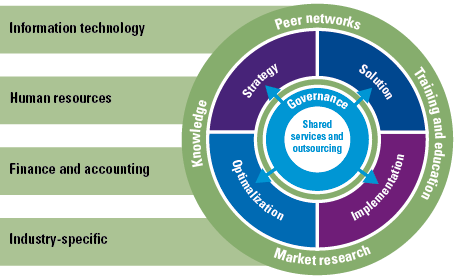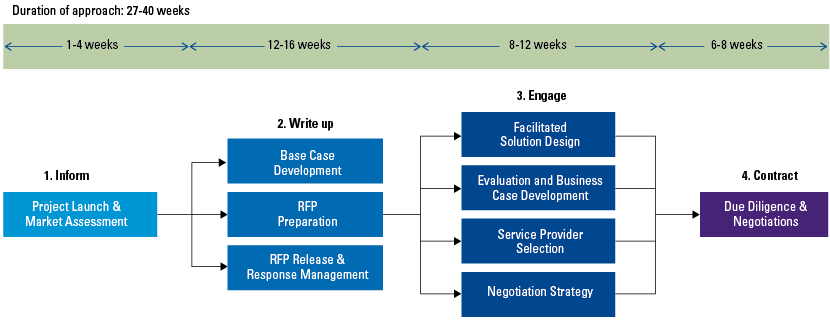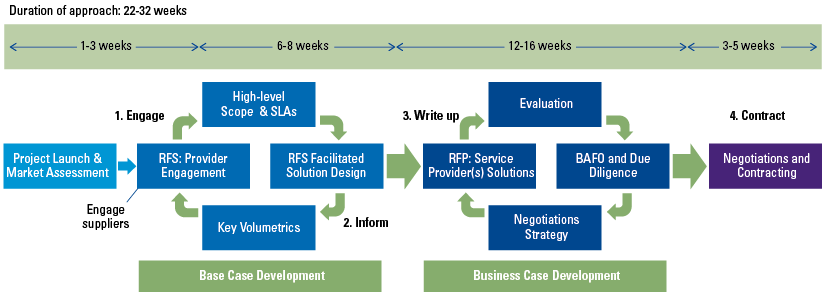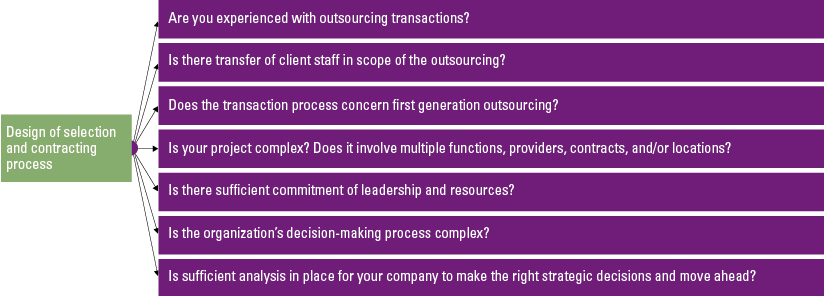An agile approach to sourcing can effectively shorten project timelines and improve the quality of the sourcing contract. A changing business context, more plug-and-play alternatives and the increased sourcing experience of buyers are all enablers of a new and faster approach to selection and contracting processes. However, not all companies or outsourcing projects are an appropriate match for this new approach. Candidates considering an agile approach should review a number of areas before making the decision, and should be aware of the prerequisites that need to be in place to make the project a success.
Introduction
Outsourcing projects are complex and time-consuming. Depending on the scope, an outsourcing project can take six months to a year or even more. In today’s rapidly changing business landscape, companies cannot afford to spend another year on a conventional waterfall approach for contracting sourcing services. Time to market is becoming more important, and long implementation times diminish the added value of the requested services. In addition, due to the nature of evolved services available on the market, less effort is required in the transition of services due to plug-and-play alternatives that allow a faster time to market. All of these developments make the buyer more flexible in its quest to find the right supplier and drive the need for speed and efficiency.
Finding companies that outsource for the first time becomes rare. More often we see second, third or even fourth generation outsourcing, which means that companies have gone through the contracting and execution phase of contracts multiple times before. This also means that the buyer’s experience in sourcing is increasing. Managing external suppliers is not new anymore, and buyers continue to increase their understanding of which services they require. This eliminates the need for lengthy and resource consuming transaction processes.
A changing business context, more plug-and-play alternatives and the increased sourcing experience of buyers are all enablers of a new and faster approach to selection and contracting processes. This agile approach is characterized by short iterations, increased interaction with suppliers and a strong focus on the fit between the buyer’s needs and the supplier’s standard solution offerings.
This paper provides an expert opinion on an agile approach to sourcing, including an analysis of its importance. Furthermore, it provides the reader with tips and tricks on how to effectively apply and govern an agile approach to supplier selection and contracting. To provide insight from the market, a survey was conducted among a wide variety of suppliers that deal with (agile) selection processes on a daily basis. The results are incorporated in this article.
The traditional approach: lengthy and time-consuming
Figure 1. KPMG Sourcing Lifecycle. [Click on the image for a larger image]
In the overall sourcing lifecycle (see Figure 1), the solution phase (in which selection and contracting takes place) is typically preceded by a sourcing strategy assessment. The traditional selection and contracting process follows a linear, step-by-step implementation, as shown in Figure 2. Based on our experience, the best-case scenario spans 27–40 weeks; in real life however the timelines are typically between 9 to 12 months, due to multiple rounds of the engagement phase, stretching up to 15 months in specific cases. There is a strong need from both the buyer and the suppliers to decrease the lead time for these transactions, to be able to speed up the time to market of the requested services.
Figure 2. Traditional approach to selection and contracting. [Click on the image for a larger image]
The various process steps in a traditional selection and contracting process are as follows:
1. Inform
The traditional selection and contracting process starts with an internal view on the required services and the execution of an initial high-level market assessment. In this phase the transaction team of the buyer creates the outline of the scope, drafts high level requirements, starts up the baseline and base case data gathering, and identifies stakeholders in order to setup a project team and the associated meeting structures. In this phase, there is typically no supplier involvement.
2. Write up
The next phase is focused on drafting and sending out the Request for Proposal (RFP). The transaction team of the buyer sets up a RFP structure, including detailed requirements from a solution perspective, baseline information, price sheets, and other contractual documents. Typically drafting the RFP is dominated by internal alignment and determining requirements with the various stakeholders and subject matter experts. This process is predominately based on in-house knowledge, with potential help from advisors; usually suppliers are not involved in this phase and only the limited information received during a potential RFI phase is incorporated. Lead times are determined by the complexity of the services, level of detail of requirements and the commitment of the transaction team.
3. Engage
Once ready, the selected suppliers receive the RFP and have the possibility to submit questions for clarification purposes. Once the proposals are received, the buyer’s transaction team and internal subject matter experts evaluate the suppliers’ proposals. In addition, and as part of the evaluation process, suppliers are requested to present their proposal to the buyer. This is the first time the requested services and requirements are challenged, and typically results in one or more iterations to get to a solution that is fit-for-purpose. Furthermore, the business case is created, based on the provided pricing and outcomes of the discussions with the suppliers on the solution.
After the evaluation process usually two suppliers proceed to the Best And Final Offer (BAFO) phase. During this phase, the buyer and supplier jointly, and in various iterations, work on the finalization of the solution. Furthermore, the pricing and legal terms and conditions are discussed to reach the best possible position for the buyer. Once the suppliers submit their BAFO, the buyer makes a final decision and selects the preferred supplier.
4. Contract
The buyer and preferred supplier subsequently enter the ‘Contract’ phase. In this phase there is room for a final due diligence and negotiations. The due diligence allows the supplier to gather data and insights, which helps to draft a proposal with a higher level of certainty. Due to this certainty, the risk premium can be reduced, resulting in a better deal for the buyer. Along with the final negotiations, the transition plan is worked out in more detail, resulting in a contract that is ready to be signed, and a solid preparation for the implementation (transition) phase.
What is an agile approach to supplier selection and contracting?
The term ‘agile’ refers to the constant communication and collaboration during the selection process. In an agile approach, constant interaction occurs across the transaction lifecycle between buyer and supplier who, together, incrementally establish the content of the contract, adapting it along the way as needs or markets change. This helps ensure business requirements are well understood at the point of the RPF release and, as a result, we see in projects that the traditional stretched time line can be reduced to 22–32 weeks, with a higher probability of successfully meeting the set timelines.
Figure 3. Agile approach to supplier selection and contracting. [Click on the image for a larger image]
Unlike the traditional ‘waterfall approach’, which follows a linear, step-by-step implementation, an agile approach is more fluid and maintains flexibility to change as necessary. Each of the four key steps — inform, write up, engage, and contract — is still important, but the agile approach reshuffles the order of these activities to significantly speed up time to market. This requires a much more collaborative and outcome-based approach, involving continuous interaction between the buyer and supplier.
This faster implementation is facilitated to a great extent by the quality improvement that the approach provides in the short engage and write up cycles, avoiding the long term disconnect between requirements, write up and actual needs. In addition, predefined solutions that suppliers are bringing to the table shorten the time needed to draft extensive statements of work related to the particular business environment. Now the focus is on high-level outcomes, rather than detailing the process of how those outcomes have to be achieved. And because buyers are looking at standard market offerings, there is also less negotiation around service levels, the types of equipment to use, or any of the more configurable items. Discussions take place earlier and more frequently, resulting in an easier negotiation process that takes less time.
Benefits of an agile approach to supplier selection and contracting
In traditional selection and contracting processes, the ‘Engage’ phase is the most time consuming; suppliers are only involved after the buyer has written its requirements in the RFP. Consequently, there is limited room for suppliers to understand and challenge the buyer early in the process. In order to speed up the process and benefit from the knowledge and experience of the suppliers, the agile approach facilitates interaction early in the process. This bypasses the time-consuming process of drafting, reviewing, updating and re-writing the requirements, before sending them out to the candidate suppliers. Instead, the requirements will be developed through interaction with the suppliers in various workshops.
Benefits of an agile approach
- High quality service offering. A solution that is aligned with the buyer’s business requirements and developed through multiple iterations and vast interaction with suppliers.
- Short lead time. A shorter and more efficient transactions process, enabling the buyer to reap the benefits of the new outsourcing contract earlier compared to the traditional approach.
- Stronger collaboration. Agile outsourcing builds stronger collaboration within the buyer and the supplier ecosystem. Rather than having to compete with each other, suppliers can jointly work together to solve buyers’ issues and reap rewards for the work put in.
- Focus on business outcomes. Outsourcing is evolving from the conventional procurement transaction to an accelerated and collaborative partnership, leading to an outcome-focused transaction that benefits all parties.
- Faster time to market. Be it responding to volatile demand, spinning up infrastructure, or simply driving results from the get-go, agile outsourcing makes the most of dynamic market offerings and helps organizations respond faster to change.
Which determinants should be considered when designing a supplier selection and contracting process?
We asked suppliers for the percentage of deals that they are involved in that followed an agile approach. The majority answered that less than a quarter of all deals followed an agile approach. There are several reasons for this. Apart from the fact that this agile approach to sourcing is relatively new, not all companies or outsourcing projects are an appropriate match for an agile transaction. Candidates considering an agile approach should review the following areas when designing the supplier selection and contracting process:
- Does the buyer have experience with outsourcing transactions? The readiness of an organization to adopt agile sourcing depends on various factors. The maturity of the buyer, or the experience with outsourcing transactions, determines whether a buyer is capable of running an agile sourcing process.
- Is a transfer of staff applicable? When a transfer of staff is involved in the outsourcing project this also impacts the timelines. Something as sensitive as a transfer of staff cannot be rushed. Furthermore, there are often fixed timelines associated with works councils and labor unions. These timelines should be taken into consideration when drafting the overall selection and contracting process. Although the solution can be handled in an agile approach, the outcomes of the solution needs to be weighed against the HR scenario.
- Does the transaction process concern first generation outsourcing? If the buyer in the current situation has not outsourced the services yet, it will be extremely difficult to get a good idea about the required services through an agile process. Furthermore, the buyer is less likely to have the required experience with outsourcing transactions.
- Is your project complex? If the project involves multiple functions, providers, contracts, and/or locations, it should be carefully considered whether agile sourcing is the right approach as it involves more effort to maintain consistency across all domains.
- Do you have committed leadership and resources? In order to keep up the pace in the process, the buyer should have a team committed to the outsourcing project. Furthermore, leadership with the right skills and attitude are critical.
- How would you characterize your organization’s decision-making processes? A buyer that is organized hierarchically, or that has a very complex decision-making process, can impede the agile sourcing process. An agile sourcing process requires responsiveness, flexibility and above all the ability to move fast.
- Is there sufficient analysis in place for your company to make the right decision? If this is not the case, you probably need more time to gather the required information. Not having this information readily available will hinder the speed of the selection process.
Figure 4. Determinants when designing a supplier selection and contracting process. [Click on the image for a larger image]
Which prerequisites should be in place for a supplier selection and contracting process that follows an agile approach?
In the process of agile contracting, it remains important to have a good starting position. A high-level overview of the current state, volume metrics and requirements for the requested solution need to be available and supported by the internal organization. Simply said, if you want to go from A to B, you should know where you are and where you want to go to.
- Keep the requirements at a functional level, do not write out every detail, as this will be given shape during the process.
- Be sure to involve the stakeholders at an early stage of the project to get buy-in and a shared starting position. An IT sourcing strategy is very useful, it provides a clear direction and enables decision making based on goals rather than gut feeling.
- Gather the hard requirements from Legal, Security and Compliance perspectives. These points are typically not directly related to the first brainstorm session, but will have an impact on the write-up sessions and set the boundaries of what is possible. Does the buyer have a standard MSA (Master Service Agreement) that sets out the legal terms and conditions that need to be used? Use it in the shaping sessions to find blocking issues early in the process. Is there no MSA available yet? Request the standard MSA from the supplier, they all have them readily available.
- Involve Communications, Finance, HR, Tax, QA, Risk, and Legal at an early stage. These functions will most likely have a role in the project and can potentially influence the timelines.
- Properly staff the buyer transaction team and make sure resources have adequate time to join the write-up sessions with the suppliers. It will be short, but intense.
- Share the process steps and timelines with the involved suppliers and request their feedback on the feasibility. The short cycle will only work if all parties are available and have the proper resources.
Success factors when following an agile approach to sourcing
During a large number of agile transaction processes, we have identified a number of success factors when following an agile approach to sourcing. The most relevant ones are listed below:
- Before choosing an agile approach, the aforementioned prerequisites should be carefully considered. If the buyer does not match one or more of the prerequisites, there is a chance that a traditional selection and contracting process is a better option.
- The buyer should be willing to accept standard solutions, preferably plug-and-play. Typically, buyers tend to over specify the products and services. However, the faster implementation of an agile sourcing process is driven to a great extent by the predefined solutions that are offered by the suppliers. This also requires leadership buy-in to adopting new, more standardized AaS (As a Service) outsourcing options from suppliers and using a different approach to specifying requirements.
- The transaction team is responsible for managing the transactions process on behalf of the buyer organization. Buyers often underestimate the time and effort that goes into the process. A mature and dedicated transaction team with independent, self-managed resources is recommended.
- Frequent iterations driving constant communication, versus intermittent, milestone-based reviews. The ability to move fast starts with the chance to signal misunderstandings or even faults early in the process. When drafting the RFP and contract with the buyer, we preferably share a new version of the documents every week for the buyer to review. But also, with the suppliers, KPMG prefers to work in short iterations to achieve the desired result.
- An agile based sourcing process has a different heartbeat and game rules compared to traditional projects. This can lead to challenges for the suppliers, especially when the short timelines are in conflict with the availability of key staff. In order to overcome these issues, leadership involvement and commitment from suppliers participating in the selection process is critical. In the current situation, suppliers tell us that they are involved in designing the selection process in only 10-25% of all transactions.
- Due to the intensity of the process, the project will benefit from a facilitator. This facilitator informs and assists all involved parties, allowing the buyer to focus on setting the requirements and the supplier to focus on their proposal.
Pitfalls when following an agile approach to sourcing
The biggest pitfall lies with the buyer; the buyer should be prepared for an intense process with short timelines. This process requires a dedicated transaction team with additional subject matter experts from the buyer’s organization. The number of suppliers involved in the process also determines the workload; this must be taken into consideration. The goal is to invite a sufficient number of suppliers to make an informed decision, but to not overdo this by inviting too many suppliers with the risk of losing the span of control.
In an agile sourcing process, the buyer requirements are detailed over time and in various iterations. When the buyer organization is very decentralized (i.e. various business units or geographically spread), the agile process can post a challenge for internal alignment. If one or more of the business units do not conform to the company standard and require custom solutions, the transaction team should make sure that there is a sound argument for doing so.
Be aware of a supplier lock-in when entering an agile sourcing process with only two suppliers. When one of the suppliers underperform or cannot meet the requirements, there is a serious consequence for the negotiation position of the buyer. Hence, we always advise to have a minimum of three suppliers in the process. In order to select the right suppliers in this process, it is key to draft selection criteria before going ahead with the suppliers, and to have the possibility to change suppliers early in the process when it turns out the supplier is not suited for the request.
Supplier involvement
The traditional approach is time and resource consuming for the supplier; in the various process steps a team of specialists and sales people needs to work on the proposal. This team ideally is kept together for this long timeframe; speeding up the process helps in getting the right team, as long as from the start of the process this team has been setup with the right resources. It is key that the supplier makes sure this is the case, and challenges the buyer if timelines are too aggressive to meet this goal. If achieved this makes the sales cycle shorter, freeing up resources for other projects and so overall decreasing the cost of sales.
Compared to waterfall approaches, the agile approach has attention points. There will be parallel sessions in the ‘write up’ phase, which need to be staffed properly. Typically, the write up phase is executed on premises to get to the best result, conference calls, video conferencing and working remotely can impact the quality of the sessions.
Suppliers want to be involved as early as possible in contracting cycles, to be able to shape the deal and to assure the right messages get across to the buyer. In our view it is important for the supplier to speak up if timelines are not achievable. Nobody wants to be the first to say something cannot be done, but sometimes this is necessary to arrive at the best result. When given the opportunity to speak up, use it to understand and align all process steps.
Getting the team briefed and ready for the sessions is crucial for a good result. Making sure outcomes of the sessions are mutually understood and captured is a responsibility of both the buyer and supplier. Assemble the team in such a way that you cover multiple areas: solution, commercial, project support, etc. When following up on actions, be aware of the potential impact on other streams. The cross-stream element should be managed well to safeguard consistency in the proposal.
Conclusion
An agile approach to sourcing can effectively shorten project timelines and improves the quality of the sourcing contract. Outsourcing projects are complex and time-consuming. However, a changing business context, more plug-and-play alternatives and the increased sourcing experience of buyers are all enablers of a new and faster approach to selection and contracting processes. This agile approach is characterized by short iterations, increased interaction with suppliers and a strong focus on the fit between the buyer’s needs and the supplier’s standard solution offerings. Constant interaction occurs across the transaction lifecycle between buyer and supplier who, together, incrementally establish the content of the contract, adapting it along the way as needs or markets change. Unlike the traditional ‘waterfall approach’, which follows a linear, step-by-step implementation, an agile approach is more fluid and maintains flexibility to change as necessary. In order to speed up the process and benefit from the knowledge and experience of the suppliers, the agile approach facilitates interaction early in the process. This bypasses the time-consuming process of drafting, reviewing, updating and re-writing the requirements before sending it out to the candidate suppliers.
Not all companies or outsourcing projects are an appropriate match for an agile transaction. Candidates considering an agile approach should review a number of areas before making the decision, and should be aware of the prerequisites that need to be in place for an agile process. Based on the assessment made, alternative approaches that contain parts of the agile sourcing methodology can be used for a successful implementation and faster time to market. Experience on a large number of selection processes, both traditional and agile, resulted in clear success factors and pitfalls. We hope that our view and the takeaways from this paper can help companies to successfully apply an agile approach to their transaction processes.









